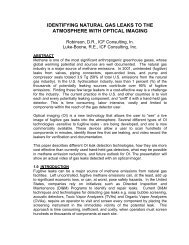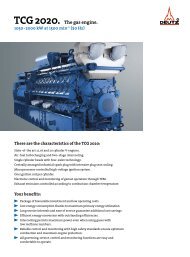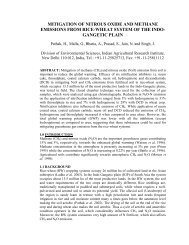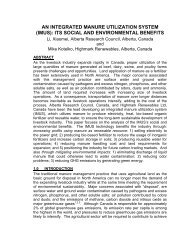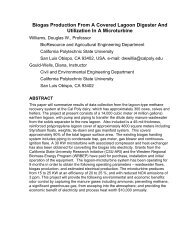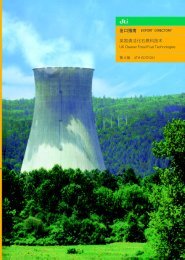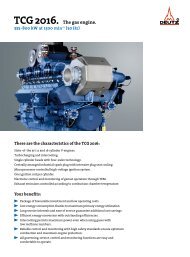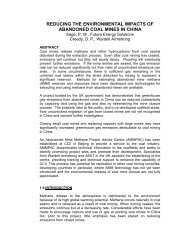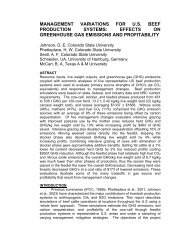introduction of catalytic flow-reversal reactor (ch4min) technology ...
introduction of catalytic flow-reversal reactor (ch4min) technology ...
introduction of catalytic flow-reversal reactor (ch4min) technology ...
You also want an ePaper? Increase the reach of your titles
YUMPU automatically turns print PDFs into web optimized ePapers that Google loves.
Mt equiv. CO 2 /y (Million metric tons <strong>of</strong> equivalent CO 2 per year) [USEPA (2002a)<br />
[3]]. In light <strong>of</strong> ever-increasing pressure for reducing GHG emissions and<br />
meeting the reduction targets set in the Kyoto Protocol, reducing VAM<br />
emissions is becoming a very important task in the 21st century.<br />
The CH4MIN <strong>technology</strong> was developed exclusively for use on treatment <strong>of</strong><br />
methane in coal mine ventilation air. With its catalyst, the CH4MIN <strong>technology</strong><br />
reduces the auto-ignition temperature <strong>of</strong> methane by several hundred degrees<br />
Celsius (i.e. to as low as 350°C). It provides a great potential for the use <strong>of</strong><br />
VAM as a principal fuel source because the <strong>technology</strong> is able to oxidize<br />
diluted methane in coal mine ventilation air and produce useable energy from<br />
heat exchangers operating at an optimal temperature. Consequently, the new<br />
<strong>technology</strong> not only provides a feasible solution to eliminate methane in<br />
ventilation air, but also could generate value through recovered energy (hot<br />
air, water and steam) during the process.<br />
2.0 CH4MIN OPERATING PRINCIPLES<br />
The schematic <strong>of</strong> a typical CH4MIN process is shown in Figure 1. It consists<br />
<strong>of</strong> a <strong>reactor</strong>, two pairs <strong>of</strong> valves and a heat removal system in the central<br />
region separating the catalyst bed in two parts. At both ends <strong>of</strong> the <strong>reactor</strong>, an<br />
inert material bed is present and acts as a thermal accumulator. Flow <strong>reversal</strong><br />
is controlled by the two sets <strong>of</strong> valves. During the first half-cycle, the methaneair<br />
mixture, which is originally at ambient temperature, is heated as it passes<br />
through the upper inert bed. It enters the upper catalyst bed at a temperature<br />
sufficient for exothermic methane oxidation to occur, which produces heat in<br />
the <strong>reactor</strong>. The stream then passes through the lower catalyst bed and finally<br />
heats the lower inert bed before exiting to atmosphere. During this first halfcycle,<br />
the upper part <strong>of</strong> the <strong>reactor</strong>, which was initially hot, cools down, while<br />
the lower part, which was initially cool, heats up. After a certain period <strong>of</strong> time,<br />
the <strong>flow</strong> direction is reversed by inverting the position <strong>of</strong> the valves in order to<br />
use the heat available in the lower inert bed. At the end <strong>of</strong> the second halfcycle,<br />
downward <strong>flow</strong> is re-established. The heat generated in excess by the<br />
exothermic chemical reaction is withdrawn by the heat removal system in the<br />
mid-section <strong>of</strong> the <strong>reactor</strong>.<br />
3.0 NUMERICAL SIMULATION AND EXPERIMENTATION<br />
A mathematical model and computer programs were developed for the study<br />
and design <strong>of</strong> CH4MIN <strong>reactor</strong>s. A transient two-dimensional heterogeneous<br />
model is combined with a numerical method allowing the fast formulation <strong>of</strong><br />
new <strong>reactor</strong> designs, [Aube and Sapoundjiev, 2000, [ 4 ] ] . The program has<br />
been validated with experiments performed with a 500-mm <strong>reactor</strong>. The<br />
comparisons between the experimental data (circles) and predictions by the<br />
model (lines) are shown in Figure 2(a-d). Good agreement with the<br />
experiments was observed. The dynamic behaviour <strong>of</strong> the CH4MIN can be<br />
predicted accurately by the model for a wide range <strong>of</strong> conditions including<br />
small <strong>reactor</strong> diameter and low air <strong>flow</strong> rate.



